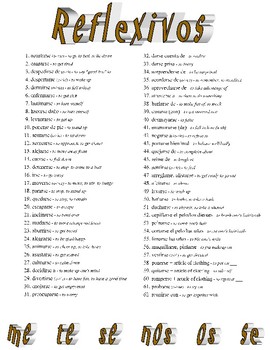
List Of Reflexive Spanish Verbs. Spanish Reflexive Verb and Pronoun Placement. Spanish Reflexive Verbs In their infinitive form reflexive verbs end with a -se after the usual -ar -er or -ir For example if you look up to shave in a SpanishEnglish dictionary youll find afeitarse and you can see from its -se ending that it is a reflexive verb. Lets take the verb banar which means to bathe. Whether or not a verb is reflexive changes the meaning of the sentence.

Acostarse to go to bed 84 as reflexive. Very Useful Spanish Reflexive Verbs to dry off dry oneself Secarse to fall asleep Dormirse to feel emotion illness Sentirse to forget olvidarse to get in Meterse to. List of Most Common Reflexive Verbs in Spanish. A small number of Spanish verbs are always reflexive including quejarse de to complain about darse cuenta de to realize and arrepentirse to repent. In the sentences below the subject performs the action on itself and the subject and object of the verb refer to the same entity. Remember that the reflexive pronoun me te se etc must be included with the verb even if the subject pronoun yo tu el etc is not.
In the reflexive form we add reflexive pronoun se ie.
All reflexive verbs have a non-reflexive version of the verb as well. Me ducho por las noches- I shower at night. Reflexive Verbs are those where the subject and object are the sameIn other words the subject does something to himself. To get sick to become ill to fall ill. Welcome to our grammar lesson about Spanish Reflexive Verbs Verbos reflexivos. In the sentences below the subject performs the action on itself and the subject and object of the verb refer to the same entity.